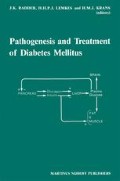Abstract
Diabetes is a disease of absolute or relative insulin deficiency which may be accompanied by a variety of pathological tissue complications. These tissue complications are much rarer in non-diabetic subjects and it is therefore reasonable to assume that they are secondary to “failure” of the normal physiological homeostatic mechanisms. Such a failure is not, however, straightforward, and the markers of what we mean by “failure” are unclear. For instance, although studies have shown that complications are more likely in those with hyperglycaemia (1,2) and with longer duration (3), such findings are statistical and not absolute. Sane patients may survive many years with poor control and have no complications at all. There may also be genetic susceptibility to complications as well as to developing diabetes (4), and our tendency to concentrate on hyperglycaemia as an index of poor control may be misguided. Many other body metabolites may be affected (5) and insulin itself may have adverse effects when given in inappropriate quantities, even when approximate normoglycaemia is achieved (6).
Access this chapter
Tax calculation will be finalised at checkout
Purchases are for personal use only
Preview
Unable to display preview. Download preview PDF.
References
Pirat J. Diabète et complications dégénératives présentation d’une étude prospective portant sur 4400 cas observés entre 1947 et 1973. Diabète et Metabolisms (Paris) 1977;3:97–107 and 245–256
Tchobroutsky G. Relation of diabetic control to development of microvascular complications. Diabetologia 1978; 15: 143–152
Dornan TL, Mann JI, Turner RC. Factors protective against retinopathy in insulin-dependent diabetics free of retinopathy for 30 years. British Medical Journal 1982; 285: 1073–1077
Barbosa J, Saner B. Do genetic factors play a role in the pathogenesis of diabetic microangiopathy? Diabetologia 1984; 27: 487–492
Gorija Y, Bahoric A, Marliss EB, Zinman B, Albisser AM. The metabolic and hormonal responses to a mixed meal in unrestrained pancreatectomised dogs chronically treated by portal or peripheral insulin infusion. Diabetologia 1981; 21: 58–64
Welborn TA, Wearne K. Coronary heart disease incidence and cardiovascular mortality in Busselton with reference to glucose and insulin concentrations. Diabetes Care 1979; 2: 154–160
Turner RC, Matthews DR. Insulin Secretion in Type I and Type II diabetes. Front Diabetes 4: 36–54 (Karger Basel 1984 )
Horwitz DL, Starr JI, Mako ME, Blackard W3, Rubenstein AH. Proinsulin,insulin and c-peptide concentrations in human portal and peripheral blood. J Clin Invest 1975; 55: 1278–1283.
Goodner CJ, Hem EG, Koerker DJ. Hepatic glucose production oscillates in synchrony with the islet secretory cycle in fasting rhesus monkeys. Science 1982; 215: 1257–59.
Holman RR, Turner RC. Maintenance of basal plasma glucose and insulin concentrations in maturity-onset diabetes. Diabetes 1979; 28: 227–230.
Turner RC, Phillips MA, Ward EA. Ultralente based insulin regimens - clinical applications, advantages and disadvantages. Acta Med Scand, Suppl 671: 75–86 1983
Unger RH, Grundy S. Hyperglycaemia as an inducer as well as a consequence of inpaired islet cell function andinsulin resistance: implications for the management of diabetes. Diabetologia 1985; 28: 119–121
Matthews DR, Lang DA, Burnett M, Turner RC. Control of pulsatile insulin secretion in man. Diabetologia 1983; 24: 231–237.
Lang DA, Matthews DR, Burnett M, Turner RC. Brief,irregular oscillations of basal plasma insulin and glucose concentrations in diabetic man. Diabetes 1981; 30: 435–439.
Matthews DR, Naylor BA, Jones RG, Ward GM, Turner RC. Pulsatile insulin has greater hypoglycaemic effect than continuous delivery. Diabetes. 1983; 32: 617–621.
Turner RC, Grayburn JA, Newman GB, Nabarro JDN. Measurement of the insulin delivery rate in man. J.Clin.Endocrinol. 1971; 33: 279–286
Verdin E, Castillo M, Luyckx AS, Lefebvre PJ. Similar metabolic effects of pulsatile versus continuous human delivery during euglycaemic, hyperinsulinaemic glucose clamp in normal man. Diabetes 1984; 33: 1169–1174
Ward JD. Continuous subcutaneous insulin infusion (CSII):Therapeutic options. Diabetic Medicine 1984; 1: 47–50
Acute mishaps during insulin pump treatment. Lancet 1985; 1: 911–912
Nabarro JDN, Mustaffa BE, Morris DV, Walport MJ, Kurtz AB. Insulin deficient diabetes. Diabetologia 1979; 16: 5–12
Turner RC,Holman RR. Insulin rather than glucose homeostasis in the pathology of diabetes. Lancet 1976; 41: 1272–1274.
Holman RR, Turner RC. A practical guide to basal and prandial insulin therapy. Diabetic Medicine 1985; 2: 450–53
Phillips M, Sinpson BW, Holman RR, Turner RC. A simple and rational twice daily insalin regime. Quarterly Journal of Medicine 1979; 191: 493–506
Heine RJ, Bilo HJG, Sikkenk AC, Van der Veen EA. Mixing short and intermediate acting insulins in the syringe: effect on postprandial blood glucose concentrations in Type I diabetics. British Medical Journal 1985; 290: 204–205
Ward GM et al. Comparison of two twice-daily insulin regimens: Soluble/Isophane and Ultralente/Soluble. Diabetologia 1981; 21: 383–386
Gale EAM, Kurtz AB, Tattersall KB. In search of the Scmogyi effect. Lancet 1980;ii:279–282
Binder C, Lauritzen T, P ramming Sf Deckert T. Pharmacokinetics of insulin. Diabetes 1982 Ed E.N.Mngola. Excerpta Medica International Congress Series 600.
Tattersall KB. Diabetes, the young person, their family and the doctor. Diabetes 1982 Ed E.N.Mngola. Excerpta Medica International Congress Series 600.
Editor information
Editors and Affiliations
Rights and permissions
Copyright information
© 1986 Martinus Nijhoff Publishers, Dordrecht
About this chapter
Cite this chapter
Matthews, D.R. (1986). Insulin: The physiological basis of its administration. In: Radder, J.K., Lemkes, H.H.P.J., Krans, H.M.J. (eds) Pathogenesis and Treatment of Diabetes Mellitus. Springer, Dordrecht. https://doi.org/10.1007/978-94-009-4301-8_15
Download citation
DOI: https://doi.org/10.1007/978-94-009-4301-8_15
Publisher Name: Springer, Dordrecht
Print ISBN: 978-94-010-8411-6
Online ISBN: 978-94-009-4301-8
eBook Packages: Springer Book Archive

